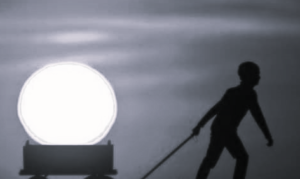How you see your world determines your future, your possibilities and your actions.

The observer and the world
The world you see is a function of the observer you are.
How you see your world determines your future, your possibilities and your actions.
How we observe does not reveal reality, it reveals our history of learning how to observe.
The successful individual sees a different world than one that fails.
The path of life is a path of learning what and how to observe for the sake of a future shared with others.
Everything we see is shaped by how we observe, what we pay attention to, and how we respond to it.
As individuals, we may ‘look’ at the same thing, and yet ‘see’ different things.
What we ‘look at’ is what is out there.
What we ‘see’ is a function of what ‘is in here’.
The claim this section makes is that the world you see is a function of the observer you are.
What you see is not just a function of what is out there, but is also always a function of how you see it.
The physical world out there is the same for everyone; however, the way we see the world or the way we perceive the world greatly differs from individual to individual.
This is because each of us is uniquely structured biologically by our history to see our world and act in it.
Physical world and the world we observe
- The physical world of does not predispose you to any action.
The world you observe not only predisposes you to action, it often propels you into action. The way you observe the world determines what actions you take.
- The physical world of facts has no impact on your results.
The way you observe the world has a great impact on your results.
Because it is this world that predisposes you into action, and it is actions that give you results
- The physical world of facts is the same for all living beings.
But you are the only person living in the world that you observe.
This world is exclusive to you.
- You can only describe the physical world you cannot change it, or recreate it in the moment. But You create the world you observe moment to moment in your thinking and speaking.
- In describing the physical world, we are talking about what’s ‘out there’. But in the world that we observe, we reveal to others the way we see. Each individual sees this world differently, and because of which the way each individual sees discloses more about the person, than what is ‘out there’.
- Our moods and emotions do not impact the physical world of facts. But our moods and emotions greatly impact the world we see. For example, in the emotion of anger, the way I perceive my world, and the way I respond to my world, will be dramatically different from the way I perceive my world and the way I respond to my world in, let’s say, the emotion of gratitude.
The concept of problems and possibilities
There is a distinct difference in observing a bird on the one hand, and problems and possibilities on the other.
Beds are physical entities.
They exist independent of the observers.
You can touch and feel a bird. Either the bird is there, or not there is a fact.
However, problems and possibilities are not like birds.
You cannot touch and feel problems or possibilities with your hands.
They do not exist independent of the observer.
On the contrary they are wholly dependent on the observer.
If the observer can see them, they exist, and if not, they do not even exist.
Unfortunately, often when an event takes place; some observers see problems and yet there are other observers also see possibilities.
Which means problems and possibilities do not exist ‘out there’.
If they existed ‘out there’, everyone would see either the problem or the possibilities, like everyone sees the bird.
Which only means that problems and possibilities exist and only exist in the ‘seeing’ of the observer.
Problems and possibilities are not facts, like the existence of the birds.
You just need to wear the lens to see possibilities, and develop the ears to listen to possibilities.
Remember, when you assess to possibilities are over (and state something like ‘it is not possible’), possibilities are not over (they never existed in the first place); it is from where you see (the observer you are) that those possibilities are over.
If you tune yourself to listen for possibilities, you open a space for possibilities to show up.
This fundamental stance that we can always create possibilities is our ‘generative’ context, reminding us that we can always invent possibilities and actions, not just be limited with ones from the past.
Different observers take different actions
While actions generate results, it’s the observer you are that gives you the actions that you take. And if you are not getting the result that you want, by all means try taking more action, implement them better, work harder and if you still do not get the results you want, it may be time to question the observer that you are, who is taking these actions.
Join the Enlighten Knowledge Community








